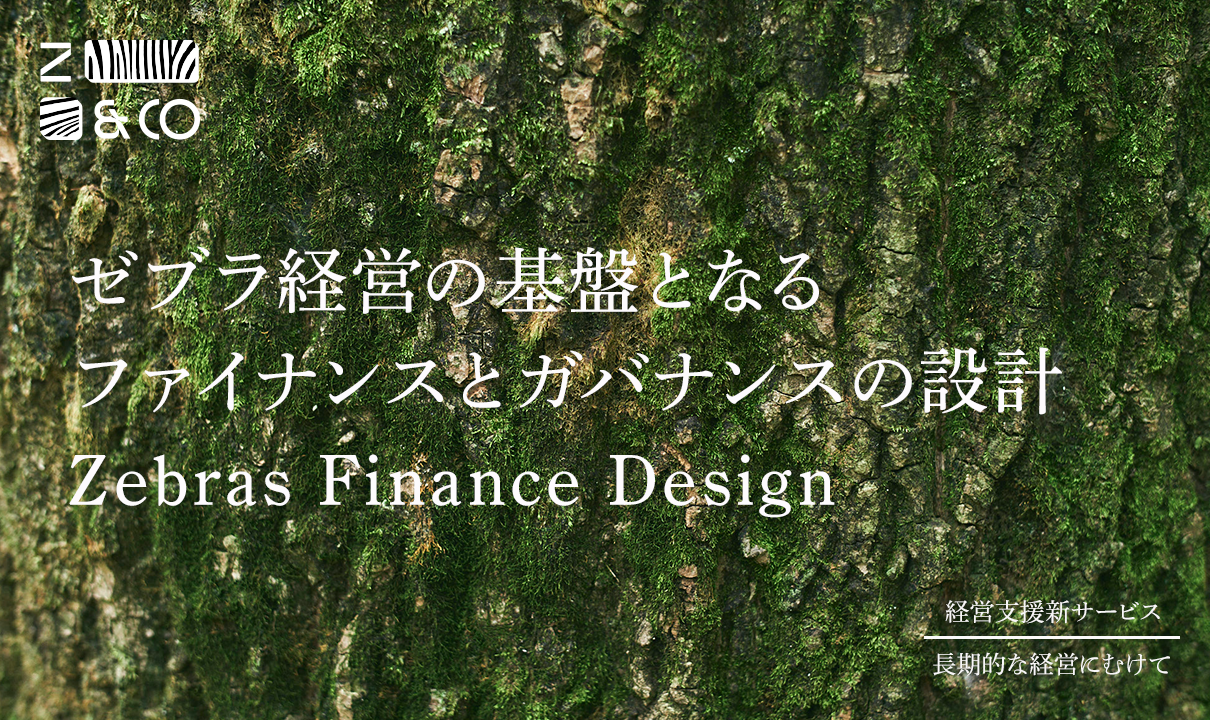
2023.06.16 ZEBRAS
Thinking about Finance Design for Zebra Companies in Terms of ‘Risk’ and ‘Decision-Making Style’

Hello,
I’m Yoshi, co-founder of Zebras and Company. For the last 2 years here at Zebras and Company, we have seen how crucial finance and governance are for the foundations of other Zebra Companies. To help these organizations, I would like to introduce the management support services we have developed.
Raising capital and funding is an unavoidable part of managing and scaling up a company, and is a process not just limited to startups. We found that it is essential to carefully consider the growth and organizational changes your company will go through when thinking about when, how, and what type (source or intention of the funds) of capital to raise. The method of raising funds is not just about collecting money necessary for activities but will take an important part in the company’s current and future decision-making processes. Some of these financing decisions cannot be undone so easily in the future, and thus here at Zebras and Company we think it is critical to plan for these things starting at the initial stages of financial planning.
However, it is not an easy task to know all of the long-term advantages and disadvantages of the many methods of raising capital at the initial stages of a company when we are all desperate to create a business and keep the lights on as well. We have had many consultation sessions about this topic with companies we are in touch with and thus we started to consider what we as Zebras and Company can do for them.
Therefore, we have decided to start a new service, “Zebra Finance Design,” to assist in designing financial and managerial plans specifically for Zebra Companies and those who are looking to take part in zebra-style governance. From here, I will explain the overview of this service and the necessary considerations for designing this particular style of finance.
“We want to eliminate the ‘I wish I knew then’ moments.”
In many cases, entrepreneurs and managers are not experts in finance. Not to mention, in the initial phases of starting a company , the top priority is to create the business and to get it off the ground, and so in many cases there might not be enough time to put a lot of thought into the financial planning.
However, it is extremely important to create a financial plan with a long term perpespective from the initial stage of the company. This is because the methods used to raise the money and what kind of money you raise is closely related to the governance of that company, such as who has the authority to make its business decisions.
For example, issuing shares is a common method of raising funds, but once you do that, the shareholders will continue to be involved in the company’s decision-making for an undecided amount of time unless they decide to sell their shares. In these cases, even if you have certain regrets about the governance style you have chosen, that financial decision makes it hard to undo those choices. We have seen many companies struggle with such issues in the past.
On the other hand, Zebra companies often have socially motivated businesses that people will empathize with. Therefore, in addition to well-known methods such as issuing company shares and bank loans, they can also raise funds through donations or grants. The available options for Zebra companies are actually wide-ranging, and by expanding your horizons with this knowledge, you can design a financial plan that truly suits your company and ideal governance style.
Having more well-informed entrepreneurs who can choose a fundraising method that suits their business nature and management style has a significant meaning for the investment side as well. This is because the type of company the investors invest in is their form of self-expression and signifies their intentions to the wider business community as well.
We hope there will be more companies in the world that can make long-term financial decisions as a way of deciding their governance style. The thought behind launching our new service is for us to support this world-view by becoming one of the positive catalysts that will help make such a world possible.
“Financing, Investing, Impact Investing, Philanthropy: Perspectives from Diverse Financial Experiences”
The thoughts I am going to share are influenced by my career, which has involved taking on various positions in different businesses and engaging with the evolving forms of finance.
After I graduated from university, I first joined a general trading company and worked in the finance business, dealing with investment-type and loan-type funds in areas such as aircraft finance and renewable energy investment. After that, I was involved in venture philanthropy at LGT VP, a pioneering presence in impact investing abroad, and Social Investment Partners in Japan. Here I had the chance to be part of utilizing loans and investments that were made using donations as a source of funds, a first for Japan. Through my work, I have experienced getting comfortable with various methods of fundraising, such as equity, debt, and philanthropy.
In addition, I have been involved in the design of corporate decision-making processes, including the composition of investors and the board of directors within these investment activities. In “Zebra Finance Design”, we will support companies by utilizing my broad range of experiences in finance.
Ideal Timing for Utilizing Our Value
At the beginning, I mentioned that it is important to plan for the long term in the early stages when growth and company structure are changing, but there is a little more nuance to the timing for financial planning for raising funds and capital. What kind of company should use our service at what timing? We envision mainly two types of companies.
One is a company that has been in business for a while and has stable sales for its products or services, and is at a timing where it wants to significantly increase its business and social impact. Conversely, for companies in the true start-up phase, we recommend prioritizing the stability of their products or services in the market first, and then consulting us afterward.
The other are companies considering business succession. For example, cases where the next generation has taken over the family business and they want to pursue the next stage in growth while valuing the existing employees and stakeholders. We have also experienced cases where the successors are looking for new ways of management to make their own company more open to the public.
From our experience, we have found successors in long-established regional companies are looking for new financial models because they have the ambition to tackle new things, but they don’t know the specific methods. This includes things such as capital planning, and although they consult with local banks or credit unions, the available options are limited to bank loans. We believe that we can be of help to companies in these situations.
Types of Finance and Their Characteristics and Principles
So, how should we actually design capital plans? Before explaining that, let’s first organize what kind of financing methods are available.
Financing methods can be broadly categorized into four types: equity, debt, share type, and philanthropy.
Equity: A practice where a company raises funds for its business by issuing new shares. There are several ways to raise funds through equity. If all three conditions apply: ① The market size is sufficiently large, ② Large profits are expected, and ③ A certain growth speed is expected – then raising funds through common stock that can be fully redeemed by a third party is appropriate. If not, raising funds through redeemable preferred stock and gradually redeeming it from the company’s profit is suitable.
Debt: A method of financing through interest-bearing debt (debt that must be repaid with interest), such as public financing, bank loans, and corporate bonds.
Share type: Revenue sharing and profit sharing, which are performance-based contracts that distribute profits. Investors invest not with the expectation of capital gains at the time of exit, but with the expectation of receiving a portion of the revenue (profit) as a return.
Philanthropy: Grants, donations, etc.
Each of these four methods has different characteristics. Depending on what kind of decision-making process you want and how much your business can limit risk, the financing method you choose changes.
For example, if you are looking for a partner to consult with about management or you want access to multiple networks to promote your product, equity financing is suitable. You get the people you want help from to become shareholders and involve them in the business’s decision-making process.
On the other hand, if you do not want to involve others in management decisions and prefer to work on the business by yourself during the initial stages, then debt, philanthropy, and share type financing are suitable.
If business risk can be limited, that is, if the business is running to some extent and there is a prospect of repaying the borrowed money, then it will be easier to raise funds through debt. Conversely, if the outlook is still unclear, then debt is an unrealistic option. In that case, you should consider raising funds through revenue sharing or profit sharing, or if it is appropriate to involve others in decision-making, equity.
On the other hand, if the business is tied to social issues and is a highly empathetic business venture, then you should also consider fundraising through grants or donations that do not require repayment.
The general idea is to consider the combination of “decision-making processes” and “risk”. And of course, financing does not happen immediately. Even with short-preparation financing, it takes several weeks to 1-2 months, so it is necessary to plan ahead.
Let’s also take a look at how these financing methods change depending on the company’s stage of growth.
Right after starting a business, the risk is high because there is no collateral or track record. In this situation, equity financing is realistic. If the business is socially empathetic, grants are also possible.
As you gradually achieve results and can predict sales to some extent, revenue sharing and profit sharing also come into view.
Debt is predicated on low risk. Generally, it becomes easier to raise funds through debt after you pass the breakeven point.
Questions to Address When Starting Financial Design
Having understood the types and characteristics of finance as described above, let’s now see how we actually design business and financial plan.
The first step is to organize the current status of your own business. By answering the following questions, you can clarify your own business and the social impact you want to create.
●Organizing Your Own Business
- What kind of challenges are you trying to solve, and for whom?
- How deep is the problem (is it at the level where people would be willing to pay for the service)?
- What business model are you using to solve the problem?
- What is the size of the market?
- What are your advantages?
- What kind of growth is expected in the business plan?
- What are your funding needs?
- How do you want to structure your decision-making process?
- What is your financial structure?
●Organizing the Social Impact You Want to Create
- Why did you decide to start this business?
- What is your vision, mission, and social impact?
- Who/what are the stakeholders you are trying to impact?
- To what extent will the social impact you are trying to make expand with business growth?
These are also the considerations we make when investing in a company. We particularly value the latter four questions about social impact. The social impact referred here is not limited to what is pursued through services. Employees, suppliers, local communities, industries, or even the global environment itself can be stakeholders.
Once you have answered the above questions and organized your company’s situation, you will clarify the “risk” and “decision-making mechanism” mentioned in the previous section, and find the most suitable method of financing based on those two criteria.
●Understanding Risk
- Do you have collateral?
- Is your operating profit margin high?
- Is the certainty of expected revenue high (do you have a track record)?
- Is the use of funds a variable cost (not a pre-investment)?
●Understanding Management Structure/Decision-Making Mechanism
- What is the current management team like?
- Do you want to involve others in the decision-making process in the future?
- Who do you want to involve in the business?
Examples of Zebra Companies and Fundraising
Let me introduce some examples of how the companies we have supported or have been involved with designed their finances.
●Last Mile Works
Industry: Digital Production
Implemented Financing Method: Debt
Desired Governance: A system where decision-makers are aligned in their commitment to produce social impact(Risk: Low Decision-Making: Not involving further members)
The initial consultation was about raising funds through equity for business growth, but as we talked, we found that they were more focused on employment and employee development than rapid growth. They already had a certain number of initial shareholders, so they chose not to involve anyone else in decision-making. Also, since they already had several years of performance and billions of yen in sales, their risk was limited. Therefore, they chose to raise funds through loans.
●Marugoto
Industry: Recruitment Support
Implemented Financing Method: Debt + Bonds
Desired Governance: A system that allows for the free use of money to produce social impact
(Risk: Low Decision-Making: Not involving further members)
The entrepreneur had previously raised funds through equity in another company he had managed. The decision-making structure collapsed when a shareholder went bankrupt, making it impossible to manage the business as he wanted. Therefore, in his current venture, he chose not to involve further members in the decision-making process. Since the risk was relatively limited, he chose to raise funds through loans.
●Hitobito
Industry: Sale of agricultural products and planning/sale of products that solve women’s health issues
Implemented Financing Method: Equity
Desired Governance: Involving diverse decision-makers through diverse stakeholders
(Risk: High Decision-Making: Involving new members)
To expand the challenging business of solving both the issues surrounding women’s health and the agricultural industry of Fukushima Prefecture while it was necessary to make preemptive investments in hiring and marketing. Therefore, to increase the scale of the business we designed the investment scheme “LIFE”, which can handle risky funds without limiting the form of exit.
Striving for a World with Diverse Zebra Management and Financing
As we have seen, there are various methods of financing zebra companies. However, until now, there has been little information that systematically summarized these methods. Through our service, we aim to share our know-how and contribute to the growth of many zebra companies.
Through our service “Zebra Finance Design” we can engage as advisors to companies that already have a CFO, and for companies without a CFO, we can get involved in a capacity similar to an external CFO. If you are interested, please feel free to contact us. We also want to collaborate with financial institutions and administrations that provide funds and we are always looking for colleagues who can think together with us.

PROFILE
ゼブラ編集部
「ゼブラ経営の体系化」を目指し、国内外、様々なセクターに関する情報を、一緒に考えやすい形に編集し、発信します。






